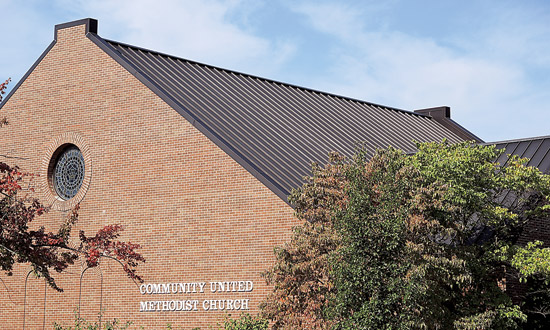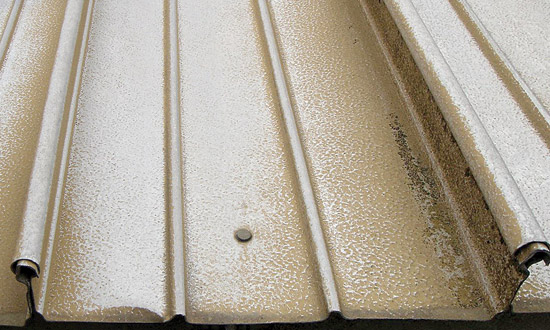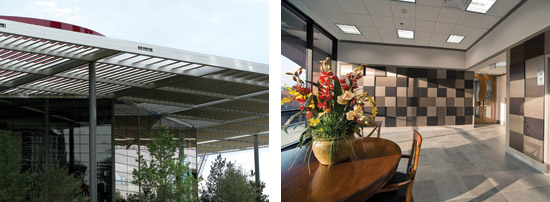Anodized Aluminum for Architectural Applications
Strength and flexibility. Aluminum's high strength-to-weight ratio has many advantages for architectural applications. It allows design professionals to build lighter structures with more stability and greater design flexibility. This can minimize expenditures on foundations and structural support elements, thereby reducing overall costs. Anodized aluminum will flex or deflect more than steel which lessens the force of impact loads.
 |
 |
After 28 years, a dark bronze anodized aluminum roof has less corrosion than a 15-year-old polyester painted roof. Photo courtesy of Lorin Industries (top) |
Corrosion resistance. The oxide layer is resistant to corrosion and is one of anodized aluminum's greatest strengths.
• The aluminum oxide layer is tenacious, hard, and instantly self-renewing because aluminum spontaneously forms a thin, but effective protective oxide layer that prevents further oxidization or corrosion if scratched.
• Anodized aluminum will not patina like copper and zinc, nor rust like steel, nor weather like brass. It is an excellent material to use in marine environments and coastal waters. Salt-water exposure will not corrode an anodized aluminum surface because of its neutral pH.
• Anodized aluminum is highly resistant to weathering, even in many industrial atmospheres that often corrode other metals. The major pollutants in an urban environment are carbon monoxide and carbon dioxide, which have no effect on an anodized aluminum surface.
Color control and selection. Anodized aluminum may be processed to any color in the visible light spectrum and is able to closely match any custom color requirements specified by architects and designers.
• As noted previously, an aluminum oxide layer has a very porous structure and will absorb staining materials such as fabric dyes or inorganic metal salts, depending upon the coloring method applied.
• Since the aluminum oxide layer is part of the aluminum itself, the dye is absorbed into the anodic layer and will not chip, flake, or peel.
• Anodized aluminum can be colored as a low-cost alternative to match other metals such as stainless steel, brass, muntz (a form of brass), bronze, zinc, gold, and copper.
• Continuous coil anodized aluminum has superior color control compared with batch processing.
 |
Left: Anodized aluminum in a clear matte finish was specified for sunshade louvers at the Winspear Opera House, Dallas, Texas. Photo courtesy of Lorin Industries (left) |
Finishing options. In addition to multiple color and metallic finishing options, manufacturers can offer other anodized aluminum finishes such as specialty embossed textures.
Production efficiencies. Anodized aluminum arrives clean and ready for immediate fabrication. Coil anodized aluminum can be processed in large coils with a significant amount of lineal feet of material. This results in less machine set-up time and less processing scrap.









